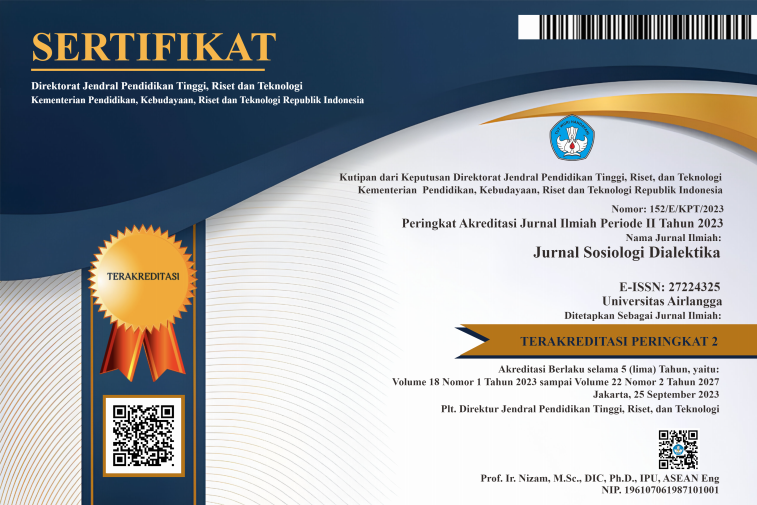Digitalization of intangible cultural heritage in the era of disruption: Utilization of social media in cultural preservation and education in schools
Downloads
The rapid advancement of digital technology has challenged conventional models of cultural preservation, particularly in safeguarding intangible cultural heritage (ICH). This study aims to analyze the digitization of ICH in the era of disruption through the utilization of social media as a strategy for cultural preservation and education in elementary schools in Sumenep District, Indonesia. Employing a mixed-methods approach, the research involved 187 elementary students through structured surveys and 17 key informants through in-depth interviews. Quantitative data were processed using SPSS, while qualitative data were thematically coded and interpreted. The findings demonstrate that while students possess a general understanding of ICH, conceptual depth remains uneven, particularly regarding ICH's philosophical, spatial, and identity dimensions. Social media platforms—primarily YouTube, TikTok, and Instagram, play a pivotal role in enhancing students’ engagement with cultural content, especially when the content is presented in visual-textual formats. Both teachers and students reported significant positive impacts, including improved cultural awareness, creativity, and appreciation for national identity. However, minor negative implications were also noted, such as distraction and misinformation. The study confirms that social media, when strategically integrated into pedagogy, enhances access to ICH knowledge and fosters cultural resilience among younger generations. In conclusion, the integration of digital platforms into cultural education constitutes an effective mechanism for preserving ICH and cultivating intergenerational cultural continuity in the digital age.
Badan Pusat Statistik (2018) Statistik Sosial Budaya. Jakarta: Badan Pusat Statistik.
Blake J (2018) Museums and safeguarding intangible cultural heritage - facilitating participation and strengthening their function in society. International Journal of Intangible Heritage 13 (13):17-32.
Cao Y, Qu X, & Chen X (2024) Metaverse application, flow experience, and Gen-Zers’ participation intention of intangible cultural heritage communication. Data Science and Management 7 (2):144-153. https://doi.org/10.1016/j.dsm.2023.12.004.
DeSoucey M, Elliott MA, & Schmutz V (2019) Rationalized authenticity and the transnational spread of intangible cultural heritage. Poetics 75: 101332-101332. https://doi.org/10.1016/j.poetic.2018.11.001.
Ding H (2022) Digital protection and development of intangible cultural heritage relying on high-performance computing. Computational Intelligence and Neuroscience 2022: 1-10. https://doi.org/10.1155/2022/4955380.
Eichler J (2020) Intangible cultural heritage, inequalities and participation: who decides on heritage? The International Journal of Human Rights 25 (5):1-22. https://doi.org/10.1080/13642987.2020.1822821.
Esfehani MH & Albrecht JN (2016) Roles of intangible cultural heritage in tourism in natural protected areas. Journal of Heritage Tourism 13 (1):15-29. https://doi.org/10.1080/1743873x.2016.1245735.
Fauzi MI (2022) Pemaknaan batik sebagai warisan budaya tak benda. Journal of Indonesian Culture and Beliefs (JICB) 1 (1). https://doi.org/10.55927/jicb.v1i1.1366.
Halder S & Sarda R (2021) Promoting intangible cultural heritage (ICH) tourism: Strategy for socioeconomic development of snake charmers (India) through geoeducation, geotourism and geoconservation. International Journal of Geoheritage and Parks 9 (2):212-232. https://doi.org/10.1016/j.ijgeop.2021.02.008.
Hou Y, Kenderdine S, Picca D, Egloff M, & Adamou A (2022) Digitizing intangible cultural heritage embodied: State of the art. Journal on Computing and Cultural Heritage 15 (3). https://doi.org/10.1145/3494837.
Lenzerini F (2011) Intangible cultural heritage: The living culture of peoples. European Journal of International Law 22 (1):101-120. https://doi.org/10.1093/ejil/chr006.
Li M, Xu S, Tang J, & Chen W (2024) Design and research of digital twin platform for handicraft intangible cultural heritage - Yangxin Cloth Paste. Heritage Science 12 (1). https://doi.org/10.1186/s40494-024-01161-0.
Li Y & Duan P (2019) Research on the innovation of protecting intangible cultural heritage in the “Internet plus” era. Procedia Computer Science 154: 20-25. https://doi.org/10.1016/j.procs.2019.06.005.
Lin Q & Lian Z (2018) On protection of intangible cultural heritage in China from the intellectual property rights perspective. Sustainability 10 (12):4369. https://doi.org/10.3390/su10124369.
Masoud H, Mortazavi M, & Farsani NT (2019) A study on tourists’ tendency towards intangible cultural heritage as an attraction (Case study: Isfahan, Iran). City, Culture and Society 17: 54-60. https://doi.org/10.1016/j.ccs.2018.11.001.
Melis C & Chambers D (2021) The construction of intangible cultural heritage: A Foucauldian critique. Annals of Tourism Research 89: 103206-103206. https://doi.org/10.1016/j.annals.2021.103206.
Noho Y, Modjo ML, & Ichsan TN (2020) Pengemasan warisan budaya tak benda “Paiya Lohungo Lopoli” sebagai atraksi wisata budaya di Gorontalo. Aksara: Jurnal Ilmu Pendidikan Nonformal 4 (2):179-192. https://ejurnal.pps.ung.ac.id/index.php/Aksara/article/view/276/248.
Purba EJ & Kurnia Putra A (2020) Perlindungan hukum warisan budaya tak beda berdasarkan Convention for the safeguarding of the intangible cultural heritage 2003 dan Penerapannya di Indonesia. Uti Possidetis: Journal of International Law 1 (1):90-117.
Qiu Q (2023) Identifying the role of intangible cultural heritage in distinguishing cities: A social media study of heritage, place, and sense in Guangzhou, China. Journal of Destination Marketing and Management 27: 100764. https://doi.org/10.1016/j.jdmm.2023.100764.
Qiu Q & Zuo Y (2023) “Intangible cultural heritage” label in destination marketing toolkits: Does it work and how? Journal of Hospitality and Tourism Management 56: 272-283. https://doi.org/10.1016/j.jhtm.2023.06.025.
Qiu Q, Zuo Y, & Zhang M (2022) Intangible cultural heritage in Tourism: Research Review and Investigation of Future Agenda. Land 11 (1):139. https://doi.org/10.3390/land11010139.
Salsabil T, Kusuma DA, & Ruchjana, BN (2023) Penerapan model spatial autoregressive pada data penetapan warisan budaya takbenda di Indonesia. Matematika: Jurnal Teori dan Terapan Matematika 22 (2):1-9. https://journals.unisba.ac.id/index.php/matematika/article/view/2560.
Skublewska-Paszkowska M, Milosz M, Powroznik P, & Lukasik E (2022) 3D technologies for intangible cultural heritage preservation literature review for selected databases. Heritage Science 10 (1):3. https://doi.org/10.1186/s40494-021-00633-x.
Su J (2018) Conceptualising the subjective authenticity of intangible cultural heritage. International Journal of Heritage Studies 24 (9):919-937. https://doi.org/10.1080/13527258.2018.1428662.
Tan SK, Tan SH, Kok YS, & Choon SW (2018) Sense of place and sustainability of intangible cultural heritage–The case of George Town and Melaka. Tourism Management 67: 376-387. https://doi.org/10.1016/j.tourman.2018.02.012.
Tanudirjo DA (2003) Warisan budaya untuk semua: Arah kebijakan pengelola warisan budaya Indonesia di masa mendatang. Makalah disampaikan pada Kongres Kebudayaan V, Bukittinggi 2003.
Ulumuddin I, Biantoro S, Nurrochsyam MW, Pratiwi I, & Julizar K (2018) Pemanfaatan literasi digital dalam pelestarian warisan budaya tak benda. Jakarta: Kementerian Pendidikan dan Kebudayaan Badan Penelitian dan Pengembangan Pusat Penelitian Kebijakan Pendidikan dan Kebudayaan.
Wang X, Zhang T, Duan L, Liritzis I, & Li J (2024) Spatial distribution characteristics and influencing factors of intangible cultural heritage in the Yellow River Basin. Journal of Cultural Heritage 66: 254-264. https://doi.org/10.1016/j.culher.2023.11.024.
Xue K, Li Y, & Meng X (2019) An evaluation model to assess the communication effects of intangible cultural heritage. Journal of Cultural Heritage 40: 124-132. https://doi.org/10.1016/j.culher.2019.05.021.
Yan Q, James HS, Xin W, & Ben HY (2024) Examining the ritualized experiences of intangible cultural heritage tourism. Journal of Destination Marketing & Management 31: 100843. https://doi.org/10.1016/j.jdmm.2023.100843.
Zhang Y, Han M, & Chen W (2018) The strategy of digital scenic area planning from the perspective of intangible cultural heritage protection. EURASIP Journal on Image and Video Processing. Article Number 130. 1-11. https://doi.org/10.1186/s13640-018-0366-7.

This work is licensed under a Creative Commons Attribution-NonCommercial-ShareAlike 4.0 International License.
1. Copyright of this journal is possession of Editorial Board and Journal Manager, by the knowledge of author, whilst the moral right of the publication belongs to the author.
2. Legal formal aspect of journal publication accessibility refers to Creative Commons Attribution-NonCommercial-ShareAlike (CC BY-NC-SA), implies that publication can be used for non-commercial purposes in its original form (cannot be modified).
3. Every publications (printed/electronic) are open access for educational purposes, research, and library. Other that the aims mentioned above, editorial board is not responsible for copyright violation.















